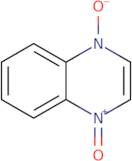
Información del producto
- 1-oxoquinoxalin-1-ium-4(1H)-olate
- BAY-Va 9391
- Bayo N-Ox
- Ccris 1570
- Celbar
- Chindoxin
- Chindoxin [Czech]
- Chinoxalin-1,4-dioxid
- Chinoxalin-1,4-dioxid [Czech]
- Grofas
- Ver más sinónimos
- Ici 8173
- Nsc 193508
- Nsc 21653
- Quindoxin [INN:BAN]
- Quindoxina
- Quindoxina [INN-Spanish]
- Quindoxine
- Quindoxine [INN-French]
- Quindoxinum
- Quindoxinum [INN-Latin]
- Quinoxaline 1,4-di-N-oxide
- Quinoxaline 1,4-dioxide
- Quinoxaline N,N-dioxide
- Quinoxaline di-N-oxide
- Quinoxaline dioxide
- Unii-Amx8J6Ys1H
- Usaf H-1
- Quindoxin
- Quindoxin
Quinoxaline-1,4-diium-1,4-bis(olate) is a genotoxic agent that has been shown to cause DNA damage and mutations. In vitro assays have shown that this substance is reactive with human serum in a photochemical reaction, which generates malonic acid and oxidative DNA. It also inhibits bacterial growth by binding to the bacterial 16S ribosomal RNA molecule, thereby inhibiting protein synthesis. This substance has been shown to be active against solid tumours in vivo. The structure of quinoxaline-1,4-diium-1,4-bis(olate) contains a chlorine atom at position 1 and 4 of the aromatic ring system. This chlorine atom can be displaced by an n-oxide group or reduced to form a quinone methide species. These reactions are thought to be responsible for the biological properties of this compound.
Propiedades químicas
Consulta técnica sobre: 3D-CAA42366 Quinoxaline-1,4-diium-1,4-bis(olate)
Si desea solicitar un presupuesto o realizar un pedido, por favor añada los productos deseados a su carrito y solicite un presupuesto o pedido desde el carrito. Es más rápido, más barato, y podrá beneficiarse de los descuentos y las ventajas disponibles.





